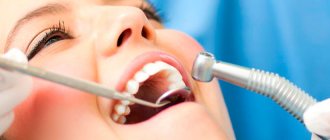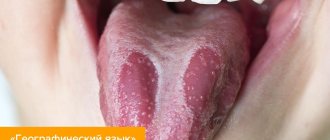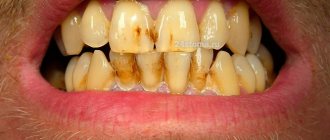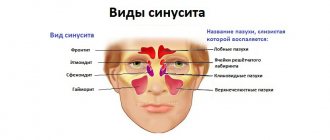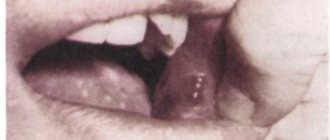To answer the question: why there is a yellow palate in the mouth (see photo), you should study the subject of attention in more detail.
When examining the mouth, in addition to the tongue, gums with teeth and the inner surfaces of the cheeks, a concave dome-shaped surface is also visible, limiting the oral cavity from above.
This palate is a mucous membrane-covered bony structure formed by the palatine processes of the two halves of the upper jaw.
The main purpose of the palate is to be a partition separating the oral cavity from the nasal cavity.
The palate performs the following functions:
- prevents saliva and food from entering the area responsible for breathing and smell recognition;
- ensures unhindered movement of inhaled and exhaled air;
- is responsible for the separate participation of the oral and nasal cavities in the function of sound formation.
In addition to the fixed bone (hard) part of the palate, there is also a soft part. This is a duplication of the mucous membrane (a fold that looks like tissue folded in half), moved up and down by a special muscle: when it contracts, the soft palate rises, and when it relaxes, it lowers.
In a calm state, the soft palate hangs down, allowing free passage of the air stream. But when swallowing, straining and blocking access from behind, from the nasopharynx, it absolutely hermetically separates the two largest cranial cavities from each other, preventing food from entering the nasal space.
Functions of the sky
The palate is a mucous membrane-covered bony structure formed by specific processes of the two halves of the upper jaw. Its main purpose is considered to be to separate the mouth from the nose. The sky performs the following functions:
- the penetration of saliva and food into the area responsible for breathing and recognizing aromas is prevented;
- serves for continuous movement of inhaled and exhaled air;
- necessary for the separate participation of the mouth and nose in the formation of sound.
In addition to the fixed bony part of the palate, there is also a soft part. It is a duplicate of the mucous membrane, which moves up and down with a special muscle: with its contraction, the soft palate rises, and when relaxed, it falls.
During a calm state, the soft palate hangs down, allowing the air stream to pass easily. But during swallowing, with tension and blocking access from behind, from the side of the nasopharynx, it hermetically separates two large cranial strips from each other, protecting the nasal cavity from the penetration of food.
Why does a yellowed sky appear?
There can be many reasons for yellow palate in the mouth. This area, like other areas of the skin and mucous membranes on and inside the head, is characterized by an abundant blood supply, which is explained by a dense network of capillaries. Due to the color of the blood flowing through them, the sky has a healthy color: the hard one is pale pink, and the soft one is pink, but of a darker tone.
Due to inflammation, the color becomes bright crimson or blue with a purple tint. If there is redness and a sore throat, then this is normal, as this is a natural reaction to an infection. What does the yellow sky in your mouth mean? This phenomenon may be associated with smoking. The resins present in tobacco and the decomposition products formed during combustion color the mucous membrane. This leads to the appearance of plaque.
In addition to staining, smoking leads to:
- disorder of blood microcirculation in tissues;
- changes in the composition and properties of blood.
Blood cells that carry only a small amount of oxygen will appear pale, as will the area they supply. In a place poorly supplied with oxygen, there is an increase in oppression and aging of cells, which is a consequence of chronic oxygen starvation.
Why does the palate in my mouth turn yellow?
The sensitive mucous membrane of the upper part of the oral cavity instantly reacts to various changes in a person’s condition. In this case, a change in its color is observed. There are several of the most common reasons why the palate and throat may turn yellow:
- Impaired patency of the digestive tract caused by inflammatory processes occurring in the large and small intestines.
- Yellow spots with a pronounced gray tint appear on the palate as a result of problems with cholesterol metabolism. The lesions not only differ in color, but also have an uneven surface compared to unaffected areas.
- A bronze reflection appears on the upper part of the oral cavity due to pathologies of the pancreas. If this problem is associated with a disruption in the functioning of the biliary system, the icteric tint of the mucous membrane intensifies.
- As a result of diseases such as diabetes, malignant tumors or tuberculosis, lipid metabolism malfunctions. At the same time, the sky turns yellow.
- Kidney problems, including chronic failure, colds and urinary tract diseases affect the color of the mucous membrane in the mouth.
- At the secondary stage of syphilis, the patient’s internal organs are exposed to infection, which significantly changes the quality of their work. As a result of liver damage, the entire mucous membrane of the palate becomes yellow.
- Age-related changes in the body lead to the fact that the upper part of the oral cavity changes color. This process is considered natural in people over 50 years of age.
The shade of the oral mucosa is directly influenced by hygiene care. If teeth are not properly brushed and germs enter, oral candidiasis may develop, requiring sanitation by a dentist and frequent treatment with antiseptic solutions.
Smoking causes the sky to change color to yellow due to the high concentration of tars contained in tobacco. This addiction leads to disruption of blood circulation and its qualitative change. Red blood cells carry less oxygen, become pale, as a result of which the mucous membranes lose their pinkish tint, become covered with uneven red spots, and veins become noticeable.
There are quite a few factors that lead to the appearance of a yellow sky. However, each disease is accompanied by its characteristic symptoms, which allows specialists to determine the exact problem and help the patient get rid of both the disease itself and yellowness in the mouth.
Liver diseases
Violation of intrahepatic metabolism causes deep disorders in the biochemistry of all organs and systems of the body, which leads to disturbances of all types of metabolism:
- protein;
- fat;
- carbohydrate;
- microelement;
- pigmented.
There is a failure in the formation of vitamins and hormones, a change in blood parameters (viscosity) occurs, which causes tissue hypoxia. The palate may turn pale, possibly loosening the mucous membrane. Often the color of the mucous membrane changes to yellow.
In case of liver diseases, the appearance of the sky will be special:
- yellowish corners of the anterior part of the soft palate are symptoms of chronic cholecystitis and gallstones;
- with cirrhosis of the liver, yellow spots appear in places of dying tissue;
- Due to viral hepatitis, the sky also turns yellow.
If yellow palate in the mouth is the cause of liver disease, then the help of a specialist is needed. This unpleasant symptom can only be eliminated through effective treatment.
Carrying out diagnostics
When a person notices that the shade of his mucous membrane or palate has changed, he should definitely consult a doctor. Initially, patients visit a dentist or therapist in this case. And when, after an examination, the doctor decides that a consultation with another specialist is needed, he can refer you to an otolaryngologist, nephrologist, gastroenterologist, oncologist, allergist, urologist, etc.
To establish a diagnosis and prescribe effective treatment, it is not enough just to see the condition of the oral cavity. Most often additional procedures are performed:
- blood, urine, stool tests;
- allergy tests;
- Ultrasound;
- MRI or CT;
- radiography.
Only with a fully collected medical history and the results of laboratory and instrumental studies can we talk about what exactly was the root cause that caused disturbances in the functioning of organs and systems. And only by eliminating the main factor can we expect that the condition of the mucous membrane will be restored.
Types of diseases that can cause pathology
Yellowness of the sky can appear due to the following ailments:
- Jaundice. It increases the concentration of the hormone bilirubin in the blood. Yellow sky is a symptom of infection with hepatitis viruses, cirrhosis of the liver, and obstruction of the biliary tract. The patient experiences nausea, vomiting, belching, and difficulty defecating. Treatment is performed after identifying the virus that caused the pigmentation changes.
- Syphilis. At stage 2, which lasts 2-5 years, symptoms of the disease appear periodically. Yellow spots usually appear in the mouth. There is a feeling of weakness and aching in the muscles. Hair loss also occurs. Unpleasant symptoms can be avoided with timely treatment. Penicillin or antibiotics are often used. We also need procedures to strengthen the immune system.
- Cholelithiasis. This is a gallstone disease that causes a yellow tint to the palate. The reason may be the filling of the gallbladder with stones formed due to the accumulation of cholesterol and salts. In this case, different methods of breaking stones are used. In advanced cases, the gallbladder must be removed through surgery.
- Cholecystitis. With it, a pronounced yellowness appears. Additional symptoms include a bitter taste in the mouth, nausea and pain in the right hypochondrium. Patients are prescribed antibiotics, means to normalize digestion, and detoxification.
What does the color of sputum indicate when you cough?
Sputum that is rusty or brown in color
The rusty color of sputum when coughing, as well as its brown shades, is often found in smokers. This happens due to the accumulation of tobacco combustion products.
In other cases, a reddish-red hue of mucus is a sign of blood in the respiratory tract. However, there is no need to panic: this happens when small blood vessels rupture during a strong cough, and the darker the mucus, the more time has passed since the blood loss.
Brown and rust-colored sputum can be caused by:
- inflammation of the bronchi or lungs;
- blockage of blood vessels;
- pneumonia;
- cystic fibrosis;
- lung abscess.
Yellow sputum
Yellow bronchial mucus is common. This is a kind of response of our immune system to the appearance of infection in the respiratory tract.
The yellow tint of mucus is characteristic of:
- flu;
- ARVI;
- bronchitis;
- sinusitis.
If the sputum is yellow when coughing and contains impurities of pus, this may indicate pneumonia. The bright canary color is characteristic of pulmonary aspergillosis, a disease caused by the mold Aspergillus.
In many cases, yellow mucus appears in the initial stages of colds. As the pathological process progresses, it acquires a greenish tint.
Green sputum
Green mucus is a sign of an active bacterial infection. The causative agents can be staphylococci, streptococci, Klebsiella.
Diseases that occur with green sputum:
- sinusitis;
- sinusitis;
- purulent bronchitis;
- laryngitis;
- pneumonia;
- cystic fibrosis (sputum is produced in the form of lumps);
- lung abscess (thick green mucus with a distinct unpleasant odor).
Green sputum when coughing gets this color due to white blood cells - neutrophils. This is the most numerous group of leukocytes, and they are the ones “attracted” by the body to fight fungal and bacterial infections. Neutrophils simply absorb pathogenic microorganisms - so they always end up in the place where the pathogen appears.
Pink or red sputum
Pink sputum usually indicates mild bleeding, which is provoked by aggressive coughing attacks. However, if symptoms do not decrease for more than three days, or the sputum becomes more saturated red, you should immediately consult a doctor.
The mucus gets its red color due to the presence of blood impurities. This symptom is typical for:
- tuberculosis;
- abscess;
- pulmonary infarction;
- oncological diseases of the respiratory system;
- pulmonary edema.
In addition, foamy mucus with bloody inclusions is a characteristic sign of anthrax.
But foamy pink sputum when coughing often indicates pulmonary edema, which in turn can be caused by heart failure. The appearance of such mucus during expectoration is a reason to consult a cardiologist.
Bloody sputum often indicates a dangerous condition, so you should never hesitate to see a doctor.
White sputum
White sputum is a signal of an inflammatory process in the respiratory tract.
- It can often be observed in the initial stages of viral bronchitis (in later stages, the mucus becomes yellow or greenish).
- Another reason for the appearance of white sputum is being in an environmentally unsafe place and, as a result, intoxication of the body. It can also be caused by taking certain medications or drugs.
- If white mucus is released in the form of lumps and the consistency resembles curdled, this may be a sign of pneumonia of fungal origin. Antibiotics do not help in this situation: to treat this type of inflammation, special antifungal therapy is required.
White sputum when coughing means that the mucous membrane of the respiratory tract is swollen. Because of this, liquid transparent mucus cannot easily move through them, and gradually acquires viscosity and a white color.
Gray or blackish sputum
A light gray tint to sputum is natural for infectious diseases in their initial stages. It could be:
- acute respiratory infections;
- ARVI;
- flu.
Saturated gray or black mucus is quite rare. In particular, miners and representatives of other professions in which they have to inhale air with a large amount of suspended particles: coal dust, iron shavings, etc., suffer from a cough with the release of this kind of sputum.
Coloring substances in products such as Coca-Cola, strong tea, and dark chocolate can also give sputum a dark color.
Smoking can also cause gray and black mucus: this is typical for long-term smokers.
In some cases, the gray color of sputum when coughing indicates an advanced stage of tuberculosis, as well as cancer of the respiratory system.
Gastrointestinal diseases
The causes of a yellow soft palate in the mouth may be associated with gastrointestinal diseases. Changes in the properties of digestive juice during inflammation cause the deposition of bile salts in the tissues of the skin and mucous membranes. Sometimes itching appears on the skin, and a change in color is observed. The same symptoms also appear on the mucous membranes lining various cavities.
The yellow palate of the mouth may be due to chronic inflammation in the small and large intestines with frequent constipation. With pathologies in the liver and pancreas, a bronze-icteric color appears on the soft palate.
Blood diseases rarely manifest themselves; they are usually a reaction to metabolic disorders in the liver or other organ systems. Why is the palate in my mouth yellow? This may be due to anemia and anemia. Also, yellow color may indicate pathology of the adrenal glands.
Gastrointestinal tract dysfunction
The shade of the oral mucosa and hard palate changes to yellowish as a result of certain pathologies of the digestive system.
- Gastric ulcer , in which lesions form on the walls of the stomach. The patient feels restlessness in the left hypochondrium most often after eating. Additional signs of this pathology include nausea, vomiting, increased gas formation, coating on the tongue and a yellow palate. The patient is prescribed a special diet, physiotherapy, recommended to avoid stressful situations, and prescribed medication. Sometimes surgery is required.
- Gastritis in chronic form is an inflammation of the gastric mucosa with the appearance of belching, heartburn, unpleasant taste in the mouth, and rumbling in the stomach. A yellowish coating on the palate and tongue is also possible. Therapeutic measures include changing eating behavior, giving up addictions - alcohol, smoking, and taking medications.
- Colitis or inflammation of the large intestine , in addition to the characteristic plaque on the hard palate and tongue, is accompanied by abdominal pain, constipation or diarrhea, an admixture of mucus, blood or purulent discharge in the stool. Treatment of colitis is carried out in hospitalization. Foods that irritate the intestines are removed from the diet. If necessary, treat with antibiotics and anthelmintics.
If symptoms characteristic of one of the above gastrointestinal diseases appear, you should immediately seek help from a gastroenterologist.
- Lump on the upper palate - what to do;
- Viscous, thick, viscous saliva in the throat - the causes of its appearance;
- Something bothers me in my throat -
Associated symptoms
As you can see from the photo, the yellow palate in the mouth looks unnatural (the image is presented in the first section of the article). In addition to this symptom, there may also be accompanying signs:
- With kidney pathologies, edema and urinary disorders are likely to occur.
- Blood diseases manifest themselves as symptoms of insufficient blood supply to organs.
- Changes in the liver are characterized by digestive and metabolic disorders.
But if, with diseases of the digestive system, metabolism also suffers, then a change in body weight occurs; with Addison's disease, crises appear. In acute adrenal and vascular insufficiency, the following appears:
- sudden sharp pain in the lumbar region, legs, abdomen;
- decreased ability to move;
- severe fever;
- intense diarrhea and vomiting;
- arterial hypotension;
- loss of consciousness;
- violation of water-salt metabolism.
In all these cases, yellow palate is likely to appear in the mouth, which is why some people immediately turn to the dentist. Brown plaque may also appear on the teeth and tongue.
What other signs could there be?
Depending on the problem that caused the change in the shade of the sky, other pathologies are also noticeable. By drawing up an overall picture of the patient’s complaints, the doctor will be able to quickly determine the disease that caused the deterioration in health.
So, in addition to yellowing of the sky there may be:
- swelling of the tissues and too frequent urination if the problem is in the kidneys;
- enlarged lymph nodes due to insufficient blood supply due to pathologies of the circulatory system;
- indigestion (constipation, diarrhea, nausea), when the functioning of the gastrointestinal tract organs is disrupted;
- weight loss sharply, for example, with Addison's disease or oncology;
- pain in the lower back, legs, abdomen, throat, depending on the location of the problem;
- increased body temperature and other signs of intoxication;
- changes in blood pressure;
- yellowing of the tongue also occurs with liver pathology;
- bitter taste.
In newborns, such problems often indicate the appearance of viral or infectious diseases of the oral cavity. Then the baby may also have red dots on the surface of the mucous membrane, yellow or white plaque, ulcers, etc.
Diagnostics
If there is a yellow palate in the mouth of an adult or child, diagnostic measures must be performed. First, they visit the dentist, where a specialist conducts an examination of the oral cavity. The doctor pays attention to other areas of the oral cavity, including the areas between the cheeks, gums, and lips. After all, it is there that signs of a certain illness, for example, thrush-candidiasis, can be detected.
Since yellow palate in the mouth of a child and an adult does not appear as an independent disease, in addition to examination by a dentist, the help of other doctors will be required. Typically referred to:
- therapist;
- ENT doctor;
- oncologist;
- allergist.
Laboratory tests of blood, urine, bile and feces are considered an important point in diagnosis. Sometimes it is necessary to conduct allergy tests and study the immune system using ultrasound, MRI, CT, and radiography. Laboratory methods may also be required.
Yellow palate in the mouth of an adult
In people over 50 years of age, the appearance of a yellow coating on the palate is considered a physiological process
If the sky has turned yellow, you should see a dentist. During the examination, the specialist will determine whether the yellowness of the mucous membrane is a sign of any disease, or indicates a lack of proper oral hygiene.
The patient’s attitude towards bad habits is also taken into account. Yellowness with a pronounced network of veins is often formed as a result of regular smoking.
When conducting diagnostics, the patient's age is taken into account. In people over 50 years of age, the appearance of yellow plaque on the palate is considered a physiological process, so serious health problems are not always detected.
The child has
A yellowed sky appears not only in adults, but also in children. In addition to dental problems, this sign may indicate other diseases, so the child should be shown to a gastroenterologist, ENT specialist, pediatrician, infectious disease specialist, or hepatologist.
Often, young patients with this symptom are diagnosed with thrush. If there is any doubt in determining the problem, it is recommended to undergo a full examination, including donating blood to check bilirubin levels.
Treatment
If the soft palate in the mouth is yellow, then timely treatment is necessary. The information obtained after undergoing diagnostics allows you to identify the disease, as well as establish its cause. If a therapeutic pathology is detected (diseases of the gastrointestinal tract, kidneys), treatment is performed by a general practitioner or a specialist:
- gastroenterologist;
- urologist;
- nephrologist.
For a systemic illness such as rheumatism, syphilis, or HIV, treatment is required in a special medical institution. If oncological pathology is detected, then therapy is carried out with an oncologist, a surgeon and consultant doctors: neurologists, ophthalmologists and other specialists of a narrow profile.
When the microbial-viral nature of the lesion in the oral cavity is identified, antiseptics and antibiotics are used. Only the dentist should prescribe them. When the acute phase of the pathology subsides, professional cleaning of the oral cavity is necessary, without which there will be no success in treatment. Sometimes repair or replacement of orthodontic structures is indicated (if there are any problems). Only the patient himself can provide personal hygiene.
Preventive measures
As a preventive measure, after eating you need to rinse your mouth with a special balm or at least clean water.
As a preventative measure, it is recommended to periodically undergo dental examinations.
This will help identify the disease at an early stage and begin a course of treatment in a timely manner, thereby preventing the development of complications.
It is also necessary to carry out daily oral hygiene procedures to remove food debris and remove plaque from the mucous membrane.
The main defense of any person is, first of all, immunity. To strengthen it, you should maintain physical fitness, radically review your diet, and enrich the body with valuable minerals and vitamins.
The following recommendations are also preventive measures:
- You should not overuse spicy, salty foods, or foods with a hard structure;
- after eating, you need to rinse your mouth with a special balm or at least clean water;
- If you experience unpleasant sensations in your mouth, rinse for several days using decoctions of propolis, chamomile, oak bark or sage.
Quitting bad habits, in particular smoking, can prevent the formation of yellow plaque on the palate.
Features of treatment
Treatment involves not only restoring the normal color of the sky, but also eliminating the main cause that led to the deviation. For yellowing of the palate and a bitter taste in the mouth, if this is associated with liver disease, herbal remedies are prescribed. These are “Gepabene”, “Hofitol”, “Silymarin”. Regenerating agents are also accepted - “Essentiale”, “Phosphogliv”, and preparations of animal origin - “Hepatosan”.
For kidney diseases, complex treatment is prescribed. Diuretics are prescribed - Furosemide, Veroshpiron. They also use antispasmodics - “Papaverine”, “No-shpa”, herbal medicines - “Canephron”, “Cyston”, drugs for lowering blood pressure - “Pentamine”, Reserpine.”
Therapy for gastrointestinal diseases is determined by the specific ailment. For example, for bacterial gastritis, antibiotics are used - Levomycetin, Tetracycline. The antibiotic Amoxicillin is effective for ulcers. To eliminate pain, antispasmodics – “Platifillin” – are used. Pepsin is used to stimulate the secretory function of the stomach. In addition to treating the underlying disease, symptomatic therapy is needed. The patient must use antiseptics. You should also rinse your mouth with a decoction of sage or chamomile, and perform salt baths (1 teaspoon of salt per 1 tablespoon of boiling water).
Treatment methods
The therapeutic approach will differ significantly depending on what exactly caused the pathology and which organ was most affected. But in any case, we need a comprehensive system that affects both the general condition of the body and relieves individual symptoms locally.
Doctors prescribe the following procedures:
- careful oral hygiene;
- professional cleaning or sanitation, elimination of infectious foci on teeth or mucous surfaces;
- antiseptic rinses;
- restorative therapy, taking vitamin-mineral complexes, immunomodulators;
- use of antibiotics when necessary;
- in the presence of viral microorganisms, antiviral drugs are needed.
If oncology or HIV is detected, treatment must take place in specialized institutions according to the therapeutic plan. When the problem is local and affects only the organs of the oral cavity, then a dentist or otolaryngologist deals with it. If there are diseases of internal systems, for example, the gastrointestinal tract, a therapist or gastroenterologist will prescribe appropriate treatment.
Folk remedies
Treatment with traditional methods is no different from those offered by medicine and dentistry. Home therapy involves:
- The use of antiseptics to be used in oral hygiene. These can be teas and infusions.
- Promoting health using traditional means. Honey and bee products are used for this.
Traditional medicine methods can only be used after consultation with a doctor. Also, do not use dubious means. Only then will the treatment bring positive results.
Treatment with traditional methods
The general principles of treatment with traditional methods do not differ from those in medicine and dentistry:
- the use of antiseptics (teas, infusions) for oral hygiene;
- increasing the level of health with the help of traditional, proven means (honey and bee products and the like).
The use of traditional medicine methods should in no way contradict the requirements of official science; proposals to use unstudied or questionable treatment methods should be categorically rejected.
The use of any form of rinse or other treatment method must be approved by the patient's attending physician.
Prevention
To prevent the appearance of yellowness in the sky, it is necessary to adhere to preventive measures. They are as follows:
- Careful and attentive oral care.
- Visit the dentist in a timely manner and follow his instructions.
- Preventing possible illnesses by strengthening your defenses. And when pathologies appear, timely treatment is required.
Thus, yellow sky appears due to various reasons. For any pathology there is an effective treatment. You need to follow the recommendations of a specialist, and then you will be able to prevent complications.
Treatment of palate cancer
The choice of treatment method for cancer of the hard and soft palate depends on the histological type and stage of the malignant tumor, the extent of the pathological process to nearby tissues. The main method of treating the disease is irradiation of a malignant neoplasm of the palate with X-rays. Radiation therapy can stop the development of cancer cells. If it is started at an early stage, complete destruction of the malignant neoplasm is possible. Radiation is performed before and after surgery.
Surgery for palate cancer involves removing the tumor and the soft tissue and bones located next to it. After surgery, a defect remains on the face, to eliminate which plastic surgery is performed. In advanced cases of cancer, surgery and radiation therapy sessions are performed.
For palate cancer, treatment is carried out with cytostatic drugs. They are administered as droppers or prescribed for oral administration. Chemotherapy for cancer of the soft and hard palate is effective in combination with radiation and surgery. The action of chemotherapeutic drugs is aimed at preventing and eliminating metastatic foci.
Timely diagnosis and selection of a well-designed treatment regimen allow doctors at the oncology clinic to achieve an almost complete cure for 80% of patients. If you experience unpleasant sensations in the oral cavity, contact oncologists and make an appointment by calling the Yusupov Hospital.


